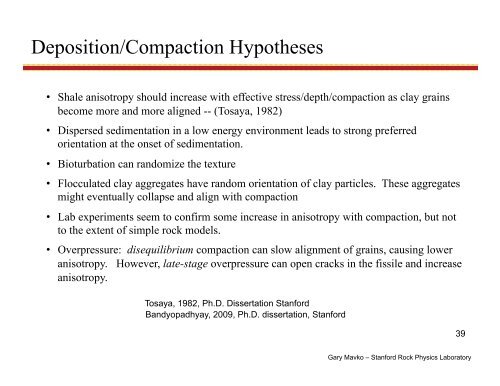Rock Physics of Shale - Stanford University
Rock Physics of Shale - Stanford University
Rock Physics of Shale - Stanford University
Create successful ePaper yourself
Turn your PDF publications into a flip-book with our unique Google optimized e-Paper software.
Deposition/Compaction Hypotheses<br />
• <strong>Shale</strong> anisotropy should increase with effective stress/depth/compaction as clay grains<br />
become more and more aligned -- (Tosaya, 1982)<br />
• Dispersed sedimentation in a low energy environment leads to strong preferred<br />
orientation at the onset <strong>of</strong> sedimentation.<br />
• Bioturbation can randomize the texture<br />
• Flocculated clay aggregates have random orientation <strong>of</strong> clay particles. These aggregates<br />
might eventually collapse and align with compaction<br />
• Lab experiments seem to confirm some increase in anisotropy with compaction, but not<br />
to the extent <strong>of</strong> simple rock models.<br />
• Overpressure: disequilibrium compaction can slow alignment <strong>of</strong> grains, causing lower<br />
anisotropy. However, late-stage overpressure can open cracks in the fissile and increase<br />
anisotropy.<br />
Tosaya, 1982, Ph.D. Dissertation <strong>Stanford</strong><br />
Bandyopadhyay, 2009, Ph.D. dissertation, <strong>Stanford</strong><br />
39<br />
Gary Mavko – <strong>Stanford</strong> <strong>Rock</strong> <strong>Physics</strong> Laboratory
















